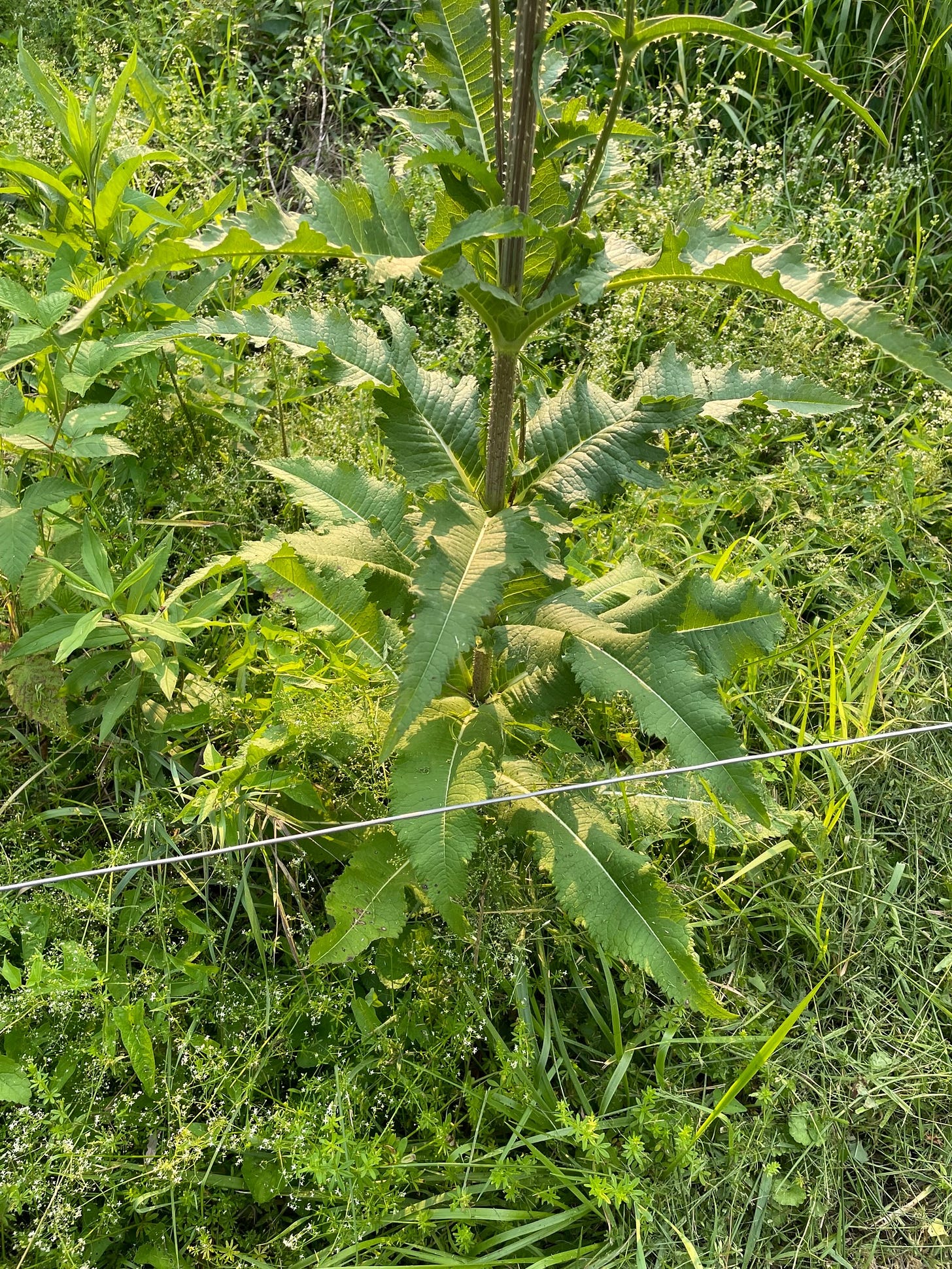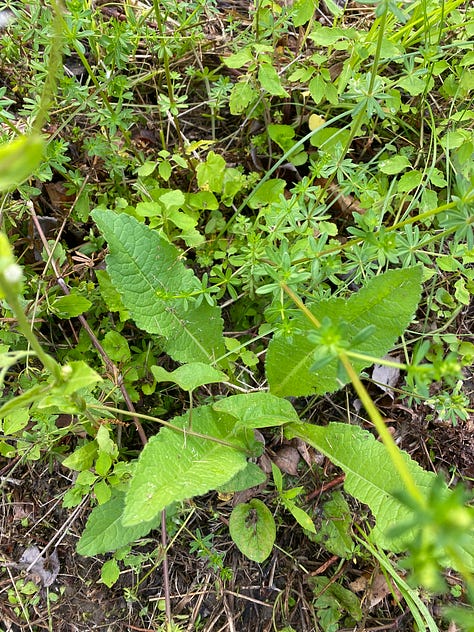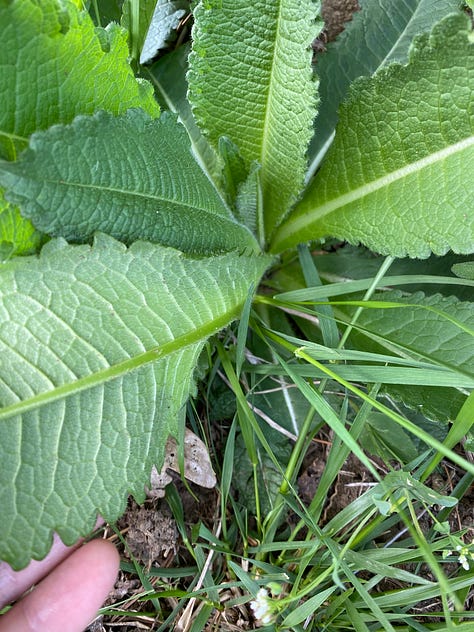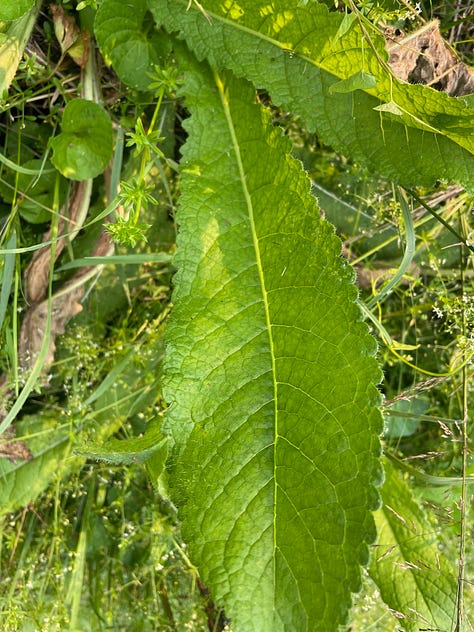Dipsacus
Teasel, Your Spiky Friend
Right around the time that the Newz was scaring our region with the supposed “arrival” of Lyme disease, we had a mega bloom of Dipsacus. It was Everywhere! At weedom, we were naturally seeing it as a message from the Creator- “Got some goodies for you”. The highways were totally lined with it. It invaded the greenhouse and the paths between our raised bed. It’s still quite plentiful, a couple years later. We dug up a few pounds of roots for a buddy whose kid was hit with Lyme disease, and made some fresh root tincture for ourselves, just in case. Stuff really does tend to show up right as we need it. We try to pay it forward by helping people to notice more of Creator’s beneficence.
We have some new Dipsacus roots drying right now. This biennial plant can be harvested preferentially in the fall of the first year, or the spring of the second year, before the flowering stem is sent up.

Time to go find some Dipsacus, teasel, or teazle. This genus, based on genetic studies, has recently been moved from its own family Dipsaceae, to the Caprifoliaceae, which - believe it or not- is the honeysuckle family. Adding to the confusion is the use of Dipsacus fullonum, and Dipsacus sylvestris, to refer to the same species. Some people say that D. sylvestris is wilder. But the truly domesticated Dipsacus is called D. sativa, and it has been traditionally cultivated for the textile industry. The heads have been used to comb the nap up on wool, to make it fuzzy. D. sativus apparently doesn’t break out into the wild so much. On the other hand, D. fullonum, aka, sylvestris is gradually taking over the U.S.A. after introduction from Europe in the 1700s. More can be learned here about the use of teasel to raise the nap of wool, a practice which has all but been replaced by automation and plastic parts.
Looking for Dipsacus is pretty easy. Find the bones first: brown sticks with prickly heads, rising 1 to almost 2 meters in height, depending on conditions and how much was broken in the wind. Then look on the ground for the babies: small 1st year rosettes with thinner, less pointy ended leaves, and second year plants showing broader, thicker leaves with pointier tips. Below you can see a second year plant right behind the dead and dried plant. The first year plant is not so easy to see at the 4:00 position. Another second year plant is at the 2:00 position. Dipsacus usually has a biennial habit, existing as a rosette the first year, then dying to the ground in winter. It reemerges the second year, forming a much bigger plant. The second year plant ends up a stem with short spines and clasping leaves with a single central vein. Very regular, parallel veins emerge perpendicularly from the central vein of the leaf. The plant then forms prickly heads which flower in mid summer in a ring like pattern, often with two rings. A single plant might produce thousands of seeds which normally fall nearby. The plant then dies back to brown prickly stems and heads which will stand a year or more until the wind or some creature or human cuts them down. (Sometimes the growth process of this weed might take an extra year if conditions are not good.)

In the second year, a striking flowering stalk appears, with huge leaves, clasping the stem as it rises up to 2 meters into the air. The leaves form a large cup in which water collects, and insects drown. This has suggested plant carnivory to botanists. A 2011 study published by Shaw and Shackleton reveals that though the drowned bugs (maggots in their experiment) did not appear to add significantly to the growth or mass of the plants, they did seem to influence the success of seed formation by about 30 percent, and the seeds of the fed plants accounted for a higher proportion of the plant total mass. So, the absorption of substances from the drowned bugs perhaps are associated with the reproductive success of Dipsacus. We’ve observed various little flies and small insects drowned in the rainwater cupped by our second year weeds, and it caused us to consider the traditional use of this liquid as an eyewash less favorably. :-D




Various species of Dipsacus have traditional uses in Chinese medicine as a anti-inflammatory, remedy against bone fractures / osteoporosis, treatment for rheumatoid arthralgia, backache, weak knees, polyuria, though the seeds are diuretic. Opposite claims have been made regarding the use to promote menstruation, or to prevent miscarriage, but the latter has been characteristic of Asian species, Dipsacus asper and japonicus. Various cytotoxic saponins and other compounds have also been identified in Dipsacus species. Many herbalists such as David Winston have used it to relieve arthralgia of Lyme disease, a spirochetal infection spread by some species of ticks.
In the U.S. a big wave of enthusiasm about Dipsacus for treatment of Lyme disease came from Matthew Wood, a long standing practitioner of Western herbalism with a vast historical background and knowledge of ethnobotany. He in turn credited his colleague William LeSassier, who practiced Chinese herbalism, for inspiring the idea to apply the common Western species of Dipsacus fullonum, teasel, to treat the effects of chronic Lyme disease. Matthew Wood reported success using low doses of the tincture of teasel root, seemingly to the point of resolving the disease in some cases. His idea was that the warming effect of the herb on tissues was working against the stationary phase of Borrelia, bringing it to a state in which the body’s immune system could effectively attack it. Conventional antibiotics are able to treat the spirochetal phase of Borrelia, but don’t work well in later phases of Lyme disease, when the organism exists in a stationary phase of its lifecycle.
Bear in mind that Lyme disease is difficult to diagnose, and there is more than one vector tick species, and apparently seven causative species of Borrelia. So if you and your health care practitioners are confused as to the diagnosis and treatment, there’s a good reason. Also, many of the symptoms which have been attributed to Lyme are likely caused by concomitant infections that are also spread by the ticks.
A hunt for specific activity of Dipsacus sylvestris against Borrellia has ensued, and such has been found in ethyl acetate extract of the roots of this plant. Extraction of the leaves also produced a product which was active against the stationary (hard to treat) phase of Borellia burgdorferi, but the crude product had considerable cytotoxicity. Further purification to produce an iridoid glycoside fraction, (separated from the polyphenols and saponins) produced a good yield containing active compounds, sylvestroside III and IV, which were shown effective against Borrelia. That fraction was considerably less cytotoxic. Sylvestroside III has also been found in the roots, though in lesser quantity than second year leaves. Abundant anti-inflammatory compounds such as loganin, loganic acid and cantleyoside are also present in the roots. Additionally anti-acetylcholine esterase activity has been found within the roots, which in the past had gotten people excited about efficacy against Alzheimer’s disease, but not so much anymore. This provides another good reason (diarrhea) to consider the roots as medicine, but not as food. Though some suggest leaves of very young plants as a possible famine food (eat when desperate), the medicinal compounds in the leaves accumulate with age. Don’t eat older plants.
In any case, use of the Dipsacus root tincture has reasonable rationale for addressing Lyme disease, particularly that which has not been treated, or has not responded to antibiotics. At the very least, some relief from associated joint pain might be had. Herbalists have suggested to start low and slow (working upwards from 1 drop daily to 3 drops, three times daily), using the ethanolic tincture. This is to mitigate the untoward reaction that is possible with the killing of Borrelia organisms, and their release of toxins within the body.
Other herbalists have successfully addressed certain kinds of neuropathic and chronic pain with varying degrees of success using Dipsacus fullonum tincture, though controlled clinical trials are absent. With the increasing lockup of the opiate analgesics, pregabalin and gabapentin, many people are turning to the weeds.
Dipsacus tincture is easiest with the fresh roots. In spring, you can dig the roots of the second year plant before it shoots up the flowering stem. Clean the roots, let them dry for up to a day, scrape off any nasty or crusty outer parts, and chop the rest very fine. Place them in a jar, and just cover them with ethyl alcohol, at least 50 percent strength. Leave as little head space as possible, just enough to shake every day. Less headspace means less oxidation, and better quality tincture. Keep the tincture in the dark. Using 1 part by weight of roots, and no more than 2 parts of ethanol solution is recommended for fresh root tincture. Give it 2 to 6 weeks to extract. Alternatively dry the chopped roots away from light and store them for later use. They can be powdered for various topical applications or tinctured.
Don’t forget to share weedom with your friends who need to get some rays outside. Find some Dipsacus. Grab some cleavers before they’re completely gone to seed, if only to stick some of that weed to yourself or the kids. Bang the comment button, and perhaps suggest some late spring and summer weeds for us to cover. Got pictures? Share them in notes. Thank you for getting lost in the weeds with us!!
Where we dig
1. Hunan Zhong Yi Yao Yan Jiu Suo, ed. A Barefoot Doctor’s Manual. Rev. & enl. ed. Cloudburst Press ; distributed to the trade in the U.S.A. by S. Greene Press; 1977.
2. Shaw PJA, Shackleton K. Carnivory in the Teasel Dipsacus fullonum — The Effect of Experimental Feeding on Growth and Seed Set. PLOS ONE. 2011;6(3):e17935. doi:10.1371/journal.pone.0017935
3. Tao Y, Ren Y, Li W, et al. Comparative pharmacokinetic analysis of extracts of crude and wine-processed Dipsacus asper in rats by a sensitive ultra performance liquid chromatography-tandem mass spectrometry approach. J Chromatogr B Analyt Technol Biomed Life Sci. 2016;1036-1037:33-41. doi:10.1016/j.jchromb.2016.09.024
4. Marques AR, Strle F, Wormser GP. Comparison of Lyme Disease in the United States and Europe. Emerg Infect Dis. 2021;27(8):2017-2024. doi:10.3201/eid2708.204763
5. Skała E, Szopa A. Dipsacus and Scabiosa Species-The Source of Specialized Metabolites with High Biological Relevance: A Review. Molecules. 2023;28(9):3754. doi:10.3390/molecules28093754
6. Witkowska-Banaszczak E. Dipsacus fullonum L. Leaves and Roots -Identification of the Components of the Essential Oils and Alpha-amylase Inhibitory activities of Methanolic Extracts. Acta Poloniae Pharmaceutica - Drug Research. 2018;75(4):951-957. doi:10.32383/appdr/83747
7. Dipsacus fullonum Teasel, Fuller’s teasel PFAF Plant Database. Accessed May 16, 2023. https://pfaf.org/user/Plant.aspx?LatinName=Dipsacus+fullonum
8. Dipsacus japonicus (Xu Duan) - Practical Plants. Accessed May 16, 2023. https://practicalplants.org/wiki/dipsacus_japonicus/
9. Saar-Reismaa P, Bragina O, Kuhtinskaja M, et al. Extraction and Fractionation of Bioactives from Dipsacus fullonum L. Leaves and Evaluation of Their Anti-Borrelia Activity. Pharmaceuticals (Basel). 2022;15(1):87. doi:10.3390/ph15010087
10. Liebold T, Straubinger RK, Rauwald HW. Growth inhibiting activity of lipophilic extracts from Dipsacus sylvestris Huds. roots against Borrelia burgdorferi s. s. in vitro. Pharmazie. 2011;66(8):628-630.
11. Debbie. Matthew Wood – I Just Gotta Share…. I Just Gotta Share... Published December 6, 2016. Accessed May 16, 2023. https://www.knowyouroots.com/ijustgottashare/tag/matthew-wood/
12. Grieve M. Modern Herbal. Echo Point Books & Media, LLC.; 2015. https://openlibrary.org/books/OL36722889M/Modern_Herbal
13. Myszkowska-Torz A, Frydrychowicz M, Tomaszewski M, Figlerowicz M, Mania A, Mazur-Melewska K. Neuroborreliosis and Post-Treatment Lyme Disease Syndrome: Focus on Children. Life (Basel). 2023;13(4):900. doi:10.3390/life13040900
14. Plant of the week – July 27th – Teasel, Dipsacus fullonum and Dipsacus sativus. Botany in Scotland. Published July 26, 2020. Accessed May 16, 2023. https://botsocscot.wordpress.com/2020/07/26/plant-of-the-week-july-27th-teasel-dipsacus-fullonum-and-dipsacus-sativus/
15. Oszmiański J, Wojdyło A, Juszczyk P, Nowicka P. Roots and Leaf Extracts of Dipsacus fullonum L. and Their Biological Activities. Plants (Basel). 2020;9(1):78. doi:10.3390/plants9010078
16. Teasel Flowers. Accessed May 17, 2023. https://www.backyardnature.net/fl_teasl.htm
17. Herbalisl. The Essence of Herbs: Teasel: Honoring the Bones of Our Ancestors. The Essence of Herbs. Published November 28, 2009. Accessed May 16, 2023. https://herbalisl.blogspot.com/2009/11/teasel-honoring-bones-of-our-ancestors.html
18. Easley T. The Modern Herbal Dispensatory - a Medicine-Making Guide.; 2016. https://openlibrary.org/books/OL26933940M/The_modern_herbal_dispensatory




In Colorado, we have the purple flowering one, as a ditch weed.
When I was last in central Europe, I found info it being recommended for gout.
Awesome post!